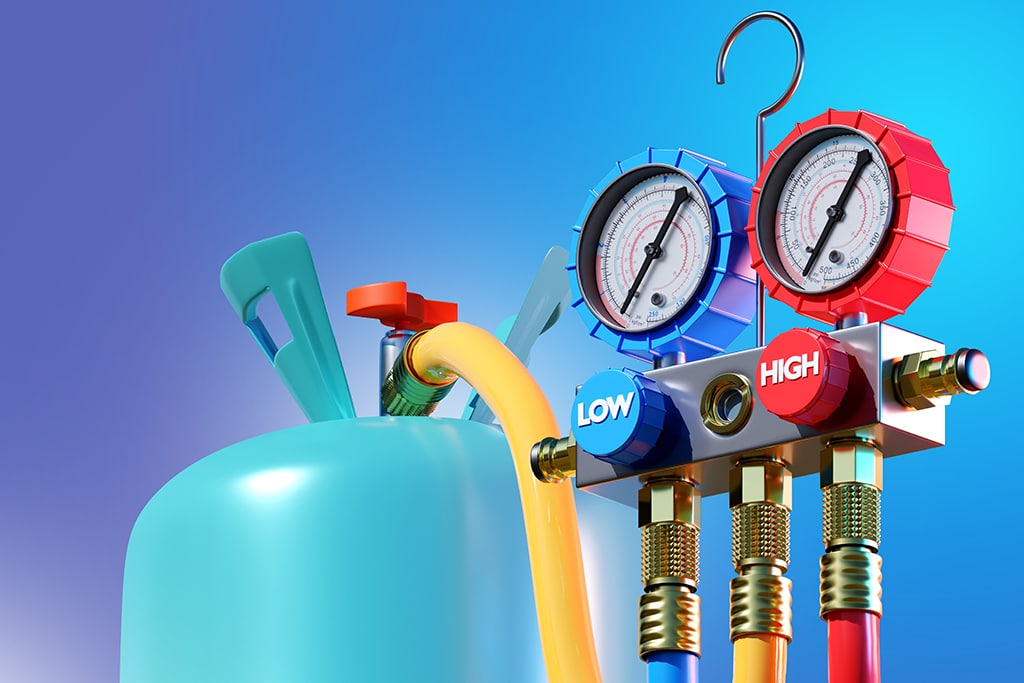
Addressing Refrigerant Causes Of Compressor Failure With Your Air Conditioning Repair Technician | Dallas, TX
Compressor failure is a huge, expensive problem in the heating and cooling industry. Even the HVAC equipment manufacturers are worried about compressor failure. To address this, they manufacture quality appliances and even extend warranties contingent on homeowners meeting some conditions. Hence, you should ensure you meet all the warranty conditions for the manufacturer to honor it. Any air conditioning repair should be done by a professional, even the most mundane ones. Since this is mostly among the main warranty requirements, failure to hire a professional to repair your AC could make it void.
What HVAC Manufacturers Have to Say About Compressor Failure
The HVAC and compressor manufacturers conduct a teardown analysis on the returned HVAC compressors. Occasionally, a manufacturer tears down the homeowner’s returned compressors for some time, analyzes them and determines the causes of failure. Although this is an expensive undertaking, the gathered information helps improve the product, spotting the causes of failure. It shows the importance of servicing the compressor and HVAC unit by an air conditioning repair company. From manufacturer defects and HVAC system problems to refrigerant issues, there are many causes of HVAC compressor failure.
Some system problems include scored shafts, broken valves, bent rods, refrigerant leaks, not cleaning the coils, clogged filters, overheating and single phasing. If you check clearly, these are problems that a routine heating and air conditioning service can address. The ability to disassemble and assemble a compressor takes experience and training, the kind that only professional air conditioning repair technicians have.
Hence, you should call a professional when you see signs of compressor failure, like loud thumping sounds, increased cooling or heating energy, reduced cooling and heating, and complete system failure. You should call an air conditioning repair technician immediately. With their experience, they will inspect the unit, determine the causes of compressor failure and advise you accordingly whether you need a replacement or a repair will suffice. Below are refrigerant issues that might result in compressor failure:
Slugging
What is slugging? This refers to a temporary return of a liquid mass comprising oil, refrigerant, or a mixture of both. Unfortunately, this normally results in broken HVAC components. Instead of the superheated vapor entering the compressor cylinders, the slug does. This phenomenon always arises at start-ups. However, a rapid change in the HVAC operating conditions can also result in slugging. Have you heard a loud knocking when you turn on the HVAC system? That is a sign of slugging, and you should have a professional heating and air conditioning repair technician come over for a deeper look.
The loud knocking sound is produced from hydraulic compression, meaning that your HVAC compressor is trying to do something that it wasn’t designed to. The unit is trying to compress a liquid. In some instances, slugging can result in discharge suction or even bending of the compressor valves. The cylinder head or valve plate gaskets might blow out at the compressor’s internal partition between the low and high sides.
If the compressor continues running with such damage, the head where the damage occurred will overheat compared to other cylinders. Slugging in the compressor can break the crankshafts and connecting rods. If the air conditioning repair company finds that the compressor has severely damaged or even broken compressor internal components, that is a sign of slugging.
During the off cycle, coolant condenses in any cold component of a system. The suction line and evaporator are the system’s coldest components. If permitted, they will gather the oil and refrigerant mixture. This liquid mixture returns to the HVAC compressor as a slug upon restart. This scenario can be avoided using a control system that “pumps downs.” Pump-down control prevents the refrigerant from migrating during the off cycle to any area of the HVAC system, including the crankcase of the compressor. This can result in improper lubrication.
Hence, you should have the air conditioning repair technician lubricate the compressor when they come for an air conditioning service. Oversized thermostatic expansion valves may hunt under light load, causing a slug. Hence, it is better that the technician slightly reduce the expansion valve size and not oversize it. Other causes of refrigerant slugging include poor suction line installation and incorrect suction line sizing.
Floodback or Flooded Starts
The continuous return of the liquid refrigerant as drops in the form of suction vapor rather than a superheated one is called floodback. When it arises, it washes the oil off the compressor bearings, resulting in the premature wearing out of the bearing surfaces. Unfortunately, this results in overheating, another serious issue regarding HVAC compressors. If it has a crankcase sight glass, you can observe the floodback as a constant oil foaming in the compressor. Whenever there is a floodback issue, your expansion device has a problem. A heating and air conditioning repair company should check and fix it.
Does the expansion device use a thermal expansion valve (TXV)? Then you should have the professional check its installation. The technician will check whether the bulb is properly insulated and located and determine whether the TXV has the correct tonnage. Remember, if the TXV is not properly installed, you cannot compensate for this by adjusting the valve. The other thing the air conditioning repair professional will check is the refrigerant superheat. If the coolant has too low superheat, more coolant will flow to the low side of the compressor than the load needs. The saturated refrigerant will have some liquid droplets within the vapor as they aren’t superheated. This gradually washes the oil off the lubricated parts of the HVAC compressor.
If a cap tube or another expansion device with a fixed orifice is used, that critically changes the system. These expansion devices don’t react much to load changes. For instance, overcharging the HVAC system will increase the head pressure and the flow rate via the expansion device. This happens until there’s much available flow for heat transfer in the HVAC evaporator coils to boil the refrigerant off entirely, resulting in floodback. Do you want to protect your compressor’s air conditioning system from floodback and slugging? Have an air conditioning repair technician install a suction line accumulator.
Accumulators are often found in low-temperature systems and used in other HVAC systems. They are also low-cost. In the off cycle, the lubricating oil in the crankcase absorbs the refrigerant, resulting in flood starts. However, the absorbed amount varies depending on the pressure and temperature within the crankcase. The oil and refrigerant mixture stratifies, with the coolant at the bottom of the crankcase at the point where the oil pump intake or bearing is located. During start-up, the lubrication of the bearings is usually marginal at best. When the crankcase pressure reduces, the coolant boils, flushing into gas and producing foaming. This foam blocks the oil passages and even might enter the cylinders, resulting in a slug formation.
All semi-hermetic use an oil pump to drive oil onto the bearing surfaces. Foam cannot be pumped using these oil pumps. Splash lubrication is essential for full hermetic compressors, and semi-hermetic compressors also use some splash lubrication. Foam won’t “splash,” though. Pump down aids in keeping extra coolant out of the crankcase, as was previously mentioned. When using crankcase heaters, make sure they are turned on at the appropriate time and, if any are present, that they aren’t burned out. With cap tube systems, the air conditioning repair technician can reduce or prevent flooded starts by adding the right amount of charge.
Lack or Loss of Lubrication
One of the main causes of HVAC compressor failure is a lack of lubrication. As you could have deduced, flooded starts and floodbacks cause a loss of lubrication. Other reasons for a loss of lubrication in the HVAC compressor are a lack of enough lubricating oil in the crankcase and a double riser suction tube needed. When was the last time you had the compressor lubricated? If you are trying to remember, have an air conditioning repair company lubricate it and other mechanical components of the HVAC system.
When the air conditioner is turned on, the compressor starts up, and the oil leaves the crankcase, traveling across the entire system. The lubricant similarly returns to the compressor as it leaves the compressor. However, foaming and flooding will make the lubricating oil leave the compressor crankcase faster. The oil also might never return to the crankcase. Some causes include a low refrigerant velocity, traps within the suction lines, low loads, HVAC short cycling, and suction line pipe errors. All these result in one thing, a loss of lubrication. You must ensure the unit is lubricated when the air conditioning repair technician comes to your home for air conditioning service. Lack of lubricating oil results in overheating due to excessive friction.
Contamination
There only should be two things in the compressor, the lubricant and the refrigerant. Anything else other than these liquids is a contaminant. Moisture, air chips, scale, non-condensable, slandering flux, brazing, and any other thing that might enter the compressor accidentally is a contaminant. These elements could enter when the air conditioning repair technician is servicing the unit or because of natural causes. Any air in the compressor displaces the coolant in the condenser coils. This causes high head pressure and temperatures that are higher than normal. The temperatures at compressor valves are about 50 degrees Fahrenheit higher than at the discharge line. The high temperatures cause the carbonization of oil in the discharge valves. An accumulation will arise, and the valves will start leaking quickly. Have you noticed a reduced cooling from the AC? You should have an air conditioning repair company inspect the refrigerant lines for leaks.
In a system, moisture and refrigerant will combine to create acids. Acids can etch parts, eat away at wires on the electrical terminals, and flow throughout the system, degrading other parts and resulting in electrical failures. Contaminants must all be removed by a professional air conditioning repair technician. Air and moisture will be removed after a thorough evacuation. Filters may catch chips and other solid pollutants like dirt. The majority of filter dryers today can remove the acid.
Unless an acid test demonstrates that the system is acid-free, replace the filter dryer, and if your HVAC system uses a semi-hermetic compressor, you should change the oil. Hire an air conditioning repair technician for good compressor installation and maintenance. It is preferable to prevent contaminants from entering a system rather than to attempt to remove them. Changing a “burned-out” compressor is the most difficult thing to do when removing pollutants.
The best course of action is to operate as though all burnouts were bad. Moisture, acids, and solids in the form of carbonized oils and “soot” will all be produced in large quantities due to the chemical processes that occur whenever a compressor burns out. Based on the size of the HVAC system, soot may extend beyond the elbow and cover the interior of the outlet pipe up to at least the first elbow. Removing, cutting off, and swapping these coated line segments for new, clean tubing is advisable.
Together with a suction line filter built for high acid removal and equipped with access fittings for measuring pressure drop via the suction line filter, a professional air conditioning repair technician must install an enlarged liquid line filter drier. Before restarting, air and moisture must be removed by deep or triple evacuation. The air conditioning repair technician has now located the cause of the burnout, fixed it, and can now run the system. The technician should evaluate the suction line filter pressure drop and acid test after 48–72 hours.
When was the last time you had the HVAC compressor lubricated? If you need help remembering, contact us at One Hour Air Conditioning & Heating of Dallas today for an inspection, lubrication, and other air conditioning services.
See our previous blog on this topic here.





